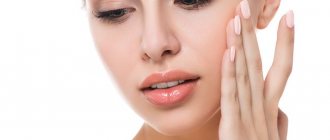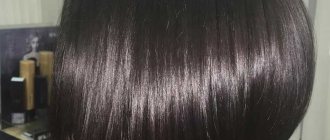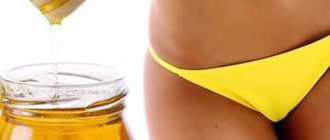Oily shine, large pores, inflammation and acne - these are the problems that owners of oily skin often face. But there is no need to dramatize, because with proper care all these troubles can be avoided. And don’t forget about the main trump card of this skin type - it ages very slowly. You will notice the first wrinkles much later than your peers, for example, with dry skin. The main thing is not to neglect effective and regular moisturizing.
Let's figure out how to maintain moisture balance without increasing oiliness or weighing down the skin? And how to choose a moisturizer that will reduce sebum levels, make your face fresh and radiant, and your skin elastic and youthful.
Why moisturize oily skin?
Oily and moisturized are two completely different skin conditions. Skin oil is a waxy substance that is secreted onto the surface of the skin to maintain its barrier function. Hydration refers to the deeper layers where moisture is absorbed, which makes the skin nourished and supple. Therefore, the skin can be oily on top and completely dry on the inside. In this case, it will begin to compensate for the loss of moisture by releasing even more sebum. Moisturizing controls oil production and reduces the skin's need to produce more secretions.
“This is what we call 'oil well in the desert' syndrome,” says David Orenteich, a leading dermatologist at Orentreich Medical Group. “Although sebum—the oil produced from the sebaceous glands—may be abundant, the surrounding skin may be dry. Sebum plays a role in retaining moisture in the surface cells of the skin; but it may not be enough on its own without a humidifier to help prevent water evaporation.”
Combination skin care
This type is quite common. The skin condition is characterized by the presence of areas of thickening with dilated openings of the sebaceous glands and increased secretion of sebum. But in people with combination skin, manifestations are observed mainly in the central part of the face and the T-zone. While on the side surfaces of the face and skin of the neck, the areas are dry.
Against the background of this type of skin, there is a risk of developing dermatoses. The basic rule for using cosmetics for combination skin is to reduce oiliness (not forgetting dry areas), to ensure the prevention of infection and inflammatory processes.
The algorithm of action for care is similar to that which should be followed for oily skin. But in this case, you will have to have two sets of products - to care for dry skin in the summer you will need separate cosmetics. Or you can use formulations labeled “for combination skin,” but they are less effective.
Regardless of the type of skin, makeup removal is a mandatory ritual before bed. Under no circumstances should you leave decorative cosmetics on your face overnight!
Moisturizing oily skin: light textures and non-greasy formulations
Moisturizers come in different forms. Moisturizer for oily skin
It should penetrate the skin easily and not block pores. It should be a weightless creamy texture, gel or lotion
.
Use non-comedogenic formulations
that do not clog pores and do not cause breakouts.
Choose water-based or dimethicone-based formulas (
a type of harmless silicone that mimics oils, leaving skin healthy and non-greasy after use).
The composition should not contain:
- coconut, olive, cocoa butter, shea butter
- beeswax
- linoleic and lauric acid
Choose products marked:
- oil-free
- water-based
- non-comedogenic
- non-acnegenic
“The choice of moisturizer really depends on your skin type and personal preference,” explains Dr. Zeichner, director of cosmetic and clinical research at Medical.
Home Remedies Recipes
You can take care of your skin in the summer yourself using available ingredients. Home scrubbing will help free pores from impurities, but the products should not be too aggressive. Formulations with a low dose of acids work best. Malic acid in low concentrations in combination with zinc and kaolin has a mild effect.
Home Recipes for General Oily Skin Care:
- To wash your face, you can mix tar soap with grape oil. But even if it is customary to carry out a hygienic procedure without additional substances, the water should be purified, at a pleasant temperature, not too hot or cold,
- As a tonic, you can use ice cubes made from aloe, lemon, mint, and chamomile.
- Moisturizing masks can be done 3-4 times a week. Honey, banana, strawberries, cucumber pulp, and herbs are suitable for these purposes. You can simply buy an alginate fabric mask that matches your skin type.
- Nutrient compositions are prepared based on cosmetic clay, fermented milk products, starch, grapefruit, potatoes, yeast, and so on. Such masks can be made no more than 2 times a week.
Only regular and high-quality care will help oily skin look beautiful, smooth and radiant. During a hot day, it is necessary to give the skin the opportunity to cleanse and rest. Thermal water and wet wipes soaked in rice powder are ideal for this.
Ideal moisturizing formula for oily skin
Effective products for oily skin should perform the following functions:
- Removing shine
Look for a product with an active ingredient that controls sebum and fights shine, absorbing excess sebum, resulting in matte, velvety skin. Use creams with a mattifying effect only for daytime care.
Look for:
mineral salts, minerals of volcanic origin, silicon and zinc salts, kaolin
- Hydration
Over-cleansing and using harsh products to control sebum and acne can damage the skin's barrier function, causing moisture loss. Replenish lost moisture with the right moisturizer.
Look for:
hyaluronic acid, glycerin, ceramides, aloe extract, thermal water
- Reduce pores and regulate sebum production
Large pores can become clogged, leading to inflammation and breakouts. For a smoother, more refined skin texture, look for a product that reduces pore size and regulates secretions. Use it for night care
Look for:
niacinamide, acids, retinol
Oily facial skin is traditionally considered problematic and is associated with something that needs to be combated, controlled, matted or eliminated. But you just need to find an approach to it. Proper and regular moisturizing with light and caring products will help you say goodbye to problems such as oily shine, clogged pores and acne forever.
Features of facial skin care
In order to maintain youth, freshness and health of the skin for a long time, you need to take care of it constantly. Oily skin type is more common in young people, but can also occur in older people due to hormonal imbalances. To determine it, you just need to put a white napkin to your forehead - greasy marks will remain on it. The following signs also indicate this type of skin:
- enlarged pores;
- the presence of blackheads and acne;
- the skin appears dense and rough;
- tendency to inflammation;
- shine after washing.
Mattifying products are a good choice for instant body skin care in summer. Proper care will help restore the condition of the dermis, remove shine and narrow pores. In summer, oily skin suffers no less than dry skin. Sebum production increases, the risk of inflammation increases, and the level of water balance worsens due to dry air both outdoors and in air-conditioned rooms.
Daily procedures in the summer should be aimed at ensuring the following effect:
- prevention of inflammation;
- cleansing particles of dust and dirt from pores;
- hydration;
- toning.
While paying attention to your face and body, you should not forget that hand skin care in summer should be complete. On the contrary, this area needs to be given more attention, since the hands and forearms are constantly exposed. The most important rule of care is UV protection. You need to go outside after applying products with an SPF level of 50. You should not get carried away with tanning; you can be exposed to the sun in the morning, until 11 o’clock, and in the evening from 16.00
IF YOU HAVE SENSITIVE SKIN
Do you think that your oily or dry skin is the most problematic and capricious of all types? Those with sensitive skin will probably object to you. Sensitive skin fully lives up to its name - it quickly reacts to “undesirable” and “unacceptable” skin care products, which can be accompanied by redness, itching, burning, and pain. Therefore, when choosing a moisturizer, we recommend following the principle “the simpler the better.” You may need to avoid artificial flavors, alpha hydroxy acids, and beta hydroxy acids (BHAs). Or use them with great caution. The fewer ingredients in the composition, the better.
Combination skin – a cosmetologist will help you care for it
In this case, dry or normal areas alternate with oily areas located in the nose, forehead and chin. There is no “typical” behavior for this type - it all depends on the specific combination of areas. Its condition may fluctuate depending on the season, hormonal changes, stress, etc.
Recommended products for combination skin:
- In winter. Products that combat cold and dryness, which often occurs due to a long stay in a room with central heating.
- In summer. Moisturizing cosmetics that prevent aging.
- Always. Products with vitamins, growth factors, peptides and antioxidants that improve the condition of skin structures.
It is recommended to use a rich cream on dry areas and a light moisturizer on oilier ones. That is, owners of such skin will need several care products.
Applying a rich cream on dry areas
Ideal procedures:
- In this case, there are no uniform recommendations - they differ for each patient. For most people, plasma injection, mesotherapy, and facial cleansing are suitable in case of acne and other skin manifestations associated with clogged pores.
- For such skin, preparations based on botulinum toxin are recommended - Dysport, Botox and their analogues, fillers (fillers) based on hyaluronic acid and other components.
It is very difficult to choose the right methods for caring for combination skin - only a cosmetologist can do this. Trying on your own can cause serious harm.
Nutrition or hydration: how to understand what your skin wants
As we age, we all encounter alarming signals that our skin sends us.
But are we deciphering them correctly? In particular, this concerns nutrition and hydration. Many people neglect to visit a specialist and try to determine their skin condition on their own. However, not everyone takes into account the possible consequences of incorrect assessment and incorrectly selected care.
Daria Yakushevich, dermatovenerologist, cosmetologist, surgeon, head of the department of facial and body aesthetics at the X-Clinic (x_clinic) adaptive medicine clinic, told Letidora readers how not to make a mistake in choosing a cream, how to use it and what ingredients to look for in the composition attention.
Our skin, as an integral part of the body, certainly needs water and “food”. It is important to understand that nutritional components and moisture are supplied to it on a residual basis. First, all the necessary substances are distributed between vital organs to ensure their functionality and performance, and only then comes the turn of the skin. Therefore, she needs help - to nourish and moisturize.
Nourishment and hydration are two important but different aspects of skin care. Nutrition
is a story about regeneration, metabolic processes in the skin, the fight against age-related changes, and
hydration
is about filling the skin with the necessary moisture.
“It is important to moisturize and nourish any skin”
To understand what your skin specifically wants, you need to evaluate it visually.
If the skin peels and feels tight after washing, it means it needs maximum hydration. At the same time, when the skin color is dull and unhealthy, these are signs of a lack of nutrients.
About skin hydration
When we say that the skin is hydrated, we mean that it is nourished with hyaluronic acid, which attracts water molecules.
Other substances are also responsible for this effect: glycerin, uric acid. Therefore, look for the listed components in the composition of skin moisturizers. In addition, cosmetics should be rich in ceramides, which create a protective mantle on the surface of the skin that prevents moisture evaporation.
It is important to understand that the skin perfectly performs its key function - protecting the body from external factors.
“Therefore, the task of molecules used in skin care products is to overcome the natural barriers of the skin.”
Pay attention to cosmetics that contain hyaluronic acid of various molecular weights: the largest of them settle on the surface and moisturize the epidermis, the medium ones reach the deeper layers of the skin, the smallest ones penetrate the skin as much as possible and retain water. This way, at the same time, we moisturize the skin from the inside and protect it from moisture evaporation.
About skin nutrition
Like our body as a whole, the skin also needs the proper amount of vitamins, amino acids and microelements. The most valuable vitamins for the skin are A, E, C and F, and the essential microelements are selenium, zinc, copper and others.
Amino acids are needed to speed up the process of collagen formation in the skin. After all, as you know, collagen is a protein consisting of amino acids.
In fact, every person is protein deficient to one degree or another, because it is impossible to satisfy all the body's needs with nutrition alone.
What to look for when choosing a cream
Many women believe that an expensive cream is just a brand and nothing more than just beautiful packaging. In reality, everything is not so simple.
Most often, behind a respected name and an attractive jar there is a colossal amount of work: a huge number of clinical trials, research and development that make it possible to understand, invent, and calculate exactly how to “carry” nutritional components through the numerous barriers of our skin.
First, the protein that comes from food goes to build vital organs and joints, and only then, according to the residual principle, goes to the skin.
Therefore, supplement your diet with collagen or ready-made amino acids and make sure that these ingredients are included in the nutritional creams.
Dermatology and cosmetics companies spend significant amounts of money on testing. Otherwise, it is impossible to create a high-quality product that works not at the level of the epidermis, but penetrates deeper.
“Cheap products are unable to work in the deep layers of the skin”
They act only on the surface of the epidermis and, as a result, deprive the skin of the necessary portion of nutrition and hydration.
Among other things, pay attention to antioxidants in cream compositions. They are unique helpers in the fight against skin aging. Free radicals are responsible for the formation of age-related and qualitative changes in the skin (these unstable atoms can damage skin cells). And antioxidants help protect cells and reduce damage to a minimum.
Take a closer look at creams with nanosomes, which are embedded in the basement membrane and “release” the nutritional components they contain deep into the skin.
The cosmetic market is crowded, and choosing the right product is quite difficult. Now there are products that contain both nutritional and moisturizing components.
“However, it is important to understand that such a “mix” reduces the effectiveness of both nutritional and moisturizing functions.”
Such a remedy will not be super effective. It is better to separate the processes of hydration and nutrition.
How to choose care depending on the time of day and season
In the spring and summer, when the skin is seriously damaged due to high solar activity, you should use moisturizing creams and serums in the morning, and nourishing ones in the evening.
“The skin needs to be moisturized during the day and provided with nourishing components in the evening.”
And all because in the afternoon the recovery processes slow down. With the help of these tools you can speed them up and make the anti-aging process more effective. During the autumn-winter period
we need to act differently. Since the skin is exposed to unfavorable environmental conditions during the day, nourishing products should be applied in the first half of the day (their texture is oilier, due to which the products are able to protect against moisture evaporation). Use moisturizers in the evening.
“If there is not enough moisture in the skin, then nourishing creams will not work as well.”
Remember that in winter
Any cream should be applied at least 30 minutes before going outside so that it has time to be absorbed. Otherwise, it will do more harm than good!
In addition, in winter it is recommended to apply tinted foundations and powder on top of moisturizing and nourishing products in order to “wrap” the skin in multiple layers.
Photo: freepik.com
Source: https://letidor.ru/krasota/pitanie-ili-uvlazhnenie-kak-ponyat-chego-khochet-vasha-kozha.htm
Back to list
HOW IT WORKS?
Let's start with the fact that our skin constantly loses moisture. This natural process is called transepidermal water loss. However, the situation may worsen, for example, due to a violation of the barrier function of the skin, including due to too frequent or improper washing, poor nutrition, poor environment, and exposure to other external or internal factors. Dehydrated skin may look dull and less elastic, change its texture, wrinkles become more noticeable, etc. These changes are also relevant for irreversible natural processes, such as aging, for example. But now we are talking about premature aging. This is something that can be influenced with proper care.
We know from school that the skin consists of several layers. External – horny. Beneath it is the epidermis, and even deeper is the dermis. Blood vessels supply precious life-giving moisture to the dermis, then the incoming water rises to the epidermis, and from there it evaporates. This is where those water-binding, occlusive and softening components can come in handy.
But keep in mind that in many cases, moisturizer alone may not be enough to eliminate dehydration. For example, occlusive and water-binding components require moisture. Otherwise, they simply will have nothing to “bind”, “attract” and “lock”. For example, one hyaluronic acid molecule can attract 700-1000 water molecules. Where can I get them from? For these purposes, as well as for targeted solutions to certain skin problems, a great variety of tonics, essences, serums, lotions, etc. have been invented. Before you start dreaming about how great it would be if there was one miracle cream that would solve all your problems at once, we have to disappoint you: unfortunately, there is no such remedy. Otherwise, how would manufacturers and marketers make money? Therefore, since you have already entered the struggle for beauty, you will have to fork out for at least one or two more products. If you are faced with a tough question of finances and need to choose “just one thing,” then we recommend that you first get a good moisturizing tonic without alcohol or harmful additives. One of its tasks is to prepare the skin for the application of other skincare products, including moisturizer. Gradually, as needed, you can add other products to your care system.
And drink more clean water. We know that perhaps only the lazy don’t talk about the body’s water balance and the notorious 1.5-2 liters of water per day. Believe me, this is important.
IF YOU HAVE NORMAL SKIN
Well, what can we say? What a score. But you already know that, right? People with normal skin are rare, and you are one of them. You most likely do not have any specific problems that require a special approach. If there are, they are probably caused by improper self-care. When choosing a moisturizer, we recommend focusing on a lighter consistency. A cream that is too thick may not suit you, which can cause breakouts. However, everything is individual. In the composition, pay attention to hyaluronic acid, niacinamide, antioxidants.









